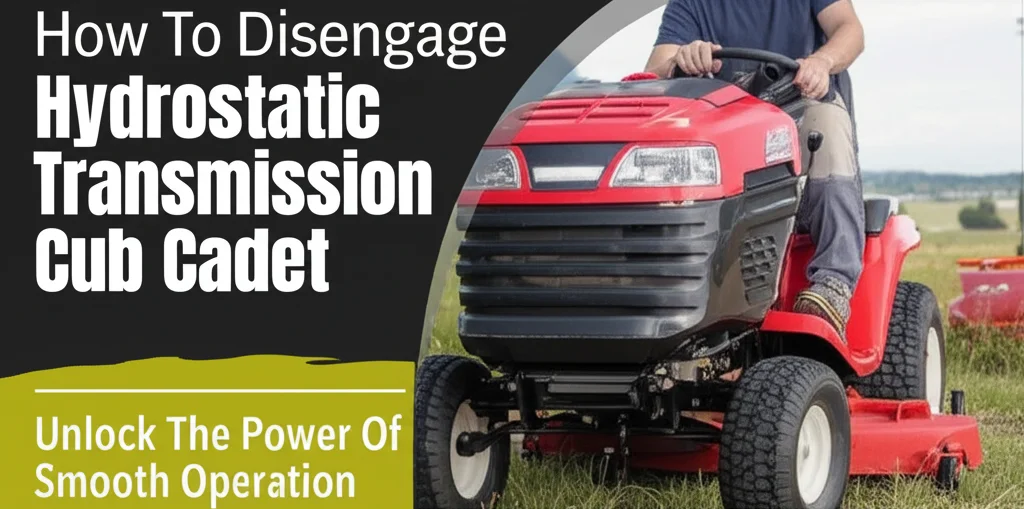· Lawn Mower Maintenance · 6 min read
How To Disengage Hydrostatic Transmission Cub Cadet Unlock The Power Of Smooth Operation

Disengaging Your Cub Cadet Hydrostatic Transmission: A Step-by-Step Guide
Have you ever needed to move your Cub Cadet riding mower without the engine running, perhaps for towing or storage? Disengaging the hydrostatic transmission is key. This process disconnects the engine from the wheels, allowing for free movement. This article will walk you through exactly how to disengage the hydrostatic transmission on your Cub Cadet, ensuring a safe and smooth operation. We’ll cover the reasons why you’d want to do this, the steps involved, and important safety precautions.
Takeaway:
- Safely disengage your Cub Cadet’s hydrostatic transmission for transport or maintenance.
- Locate and use the transmission disengagement lever or switch.
- Always follow safety guidelines to prevent damage or injury.
Quick Answer: To disengage the hydrostatic transmission on a Cub Cadet, locate the transmission disengagement lever (usually near the parking brake) and move it to the “disengaged” position. This frees the wheels, allowing you to move the mower without the engine running.
Why Disengage Your Hydrostatic Transmission?
Understanding why you need to disengage the transmission is just as important as how. Simply put, a hydrostatic transmission uses hydraulic fluid to transfer power from the engine to the wheels. When engaged, the engine is directly linked to the wheels, preventing them from rolling freely. Disengaging breaks this connection. This is crucial for several reasons, including safely towing your mower, performing maintenance, and transporting it on a trailer. Trying to move a mower with an engaged transmission can damage the system and is a safety hazard.
Locating the Disengagement Mechanism on Your Cub Cadet
The location of the disengagement mechanism varies slightly depending on your Cub Cadet model. However, it’s typically found near the parking brake pedal. Look for a lever or a switch clearly labeled “Transmission Disengage” or something similar. Some models have a dedicated lever you pull or push, while others utilize a switch that needs to be flipped. Consult your Cub Cadet owner’s manual for the precise location and operation specific to your model. Knowing exactly where this control is located will save you time and frustration.
Step-by-Step Guide to Disengaging the Transmission
Now, let’s get into the practical steps. Before you begin, ensure the mower is on a level surface and the engine is completely turned off. Here’s a breakdown of the process:
- Turn Off the Engine: This is the most important safety step. Never attempt to disengage the transmission with the engine running.
- Engage the Parking Brake: Set the parking brake firmly to prevent any accidental movement.
- Locate the Disengagement Lever/Switch: Refer to your owner’s manual if needed.
- Move to Disengage Position: Pull the lever or flip the switch to the designated “disengaged” position. You should feel a distinct click or movement.
- Test for Free Movement: Attempt to push the mower forward or backward. The wheels should now roll freely without engine resistance.
Understanding Different Disengagement Systems
Cub Cadet utilizes a few different types of disengagement systems. Knowing which one your mower has can help you troubleshoot any issues.
- Lever System: This is the most common type. A lever is pulled or pushed to mechanically disconnect the transmission.
- Switch System: Some newer models use an electrical switch to activate a solenoid that disengages the transmission.
- Bypass Valve System: Less common, this system uses a valve to redirect hydraulic fluid, effectively disengaging the transmission.
If you’re unsure which system your mower has, again, your owner’s manual is your best resource. Properly identifying the system ensures you’re using the correct procedure. If you’re dealing with a dirty engine, you might want to consider how to clean a carburetor on Cub Cadet riding mower to ensure optimal performance.
Safety Precautions When Disengaging the Transmission
Safety should always be your top priority. Here are some crucial precautions to keep in mind:
- Never Disengage with the Engine Running: This can cause serious damage to the transmission and potential injury.
- Always Use the Parking Brake: Even when disengaged, the mower can still roll, especially on a slope.
- Be Aware of Your Surroundings: Ensure there are no people or obstacles in the path of the mower.
- Avoid Rolling Down Hills: Disengaging the transmission doesn’t replace the need for careful operation on inclines.
- Re-Engage Before Starting: Always re-engage the transmission before starting the engine.
Re-Engaging the Hydrostatic Transmission
Re-engaging the transmission is just as important as disengaging it. Follow these steps:
- Ensure the Mower is on a Level Surface: This prevents unexpected movement.
- Engage the Parking Brake: Set the brake firmly.
- Move the Lever/Switch to the “Engaged” Position: Return the lever or switch to its original position.
- Verify Engagement: Attempt to move the mower. The wheels should no longer roll freely.
- Start the Engine: Now you can safely start the engine and begin mowing.
Remember, failing to re-engage the transmission before starting the engine can cause significant damage. If you’ve been towing your mower, it’s a good idea to how to clean automatic transmission fluid off of concrete to prevent staining.
Troubleshooting Common Disengagement Issues
Sometimes, the transmission disengagement mechanism may not work as expected. Here are a few common issues and potential solutions:
- Lever/Switch Feels Stuck: Check for obstructions or debris around the mechanism. Lubricate with a suitable spray lubricant.
- Wheels Still Don’t Roll Freely: Ensure the lever/switch is fully disengaged. Inspect the transmission linkage for damage.
- Transmission Won’t Engage: Check the transmission fluid level. Consult a qualified mechanic if the problem persists.
If you’re uncomfortable performing any of these troubleshooting steps, it’s best to seek professional assistance.
Frequently Asked Questions (FAQ)
Q: Can I disengage the transmission while the engine is idling? A: No, absolutely not. Always turn the engine completely off before disengaging the transmission. This prevents damage to the system and ensures your safety.
Q: What if my Cub Cadet doesn’t have a clearly labeled disengagement lever? A: Refer to your owner’s manual. It will provide specific instructions and diagrams for your model.
Q: Is it normal for the transmission to make a clicking sound when disengaging? A: A slight clicking sound is usually normal, indicating the mechanism is engaging or disengaging. However, loud or grinding noises could indicate a problem.
Q: Can I drive my Cub Cadet onto a trailer with the transmission disengaged? A: Yes, disengaging the transmission is essential for safely driving the mower onto a trailer. It allows the wheels to roll freely without engine resistance.
Conclusion
Disengaging the hydrostatic transmission on your Cub Cadet riding mower is a straightforward process when you know how. By following the steps outlined in this guide, you can safely move your mower for maintenance, transport, or storage. Remember to always prioritize safety and consult your owner’s manual for model-specific instructions. Understanding how to properly disengage and re-engage your transmission unlocks the power of smooth operation and helps prolong the life of your Cub Cadet. Now that you’ve mastered this skill, you can confidently handle various maintenance tasks and transport needs.
- hydrostatic transmission
- cub cadet
- disengage
- lawn mower repair
- riding mower
- maintenance

